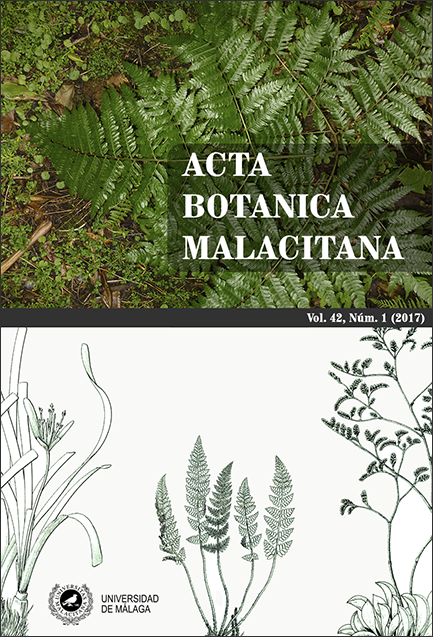Tree ferns dominate secondary succession in abandoned pineapple plantations around Manu National Park, Peru
DOI:
https://doi.org/10.24310/abm.v42i1.3004Resumen
Habitat management and restoration in buffer zones of national parks is critical for maintaining ecosystem services and biological connectivity in and around the parks’ core protected areas. Vegetation succession in abandoned plantations in buffer zones may take different paths that reach climax ecosystems in more or less time depending on the conditions of initial succession, thus enhancing or hindering biological connectivity and ecosystem services. This study documents the dominance of tree ferns in the initial stages of vegetation succession on abandoned pineapple plantations on the Andean foothills around Manu National Park, Peru, and discusses the role it may have on ecosystem restoration. Four years after abandonment, tree fern gametophytes grow under the shade of pineapple plants and melastomes. After 6-10 years of succession, the vegetation is dominated by a tree fern community composed of at least eight species, of which the most common are by far Cyathea delgadii and Cyathea microdonta. Cyathea microdonta functions as a short-lived pioneer, reaching its peak of live stem density in 6 to10 years and dying off in older plots. Cyathea delgadii, on the other hand, continues to grow and persists beyond 10 years of succession. Areas adjacent to abandoned pineapple fields have few tree ferns and higher tree species diversity, suggesting that pineapple agriculture and the resulting tree fern community may be a longer pathway to reach climax vegetation stages than other types of plantation.
Descargas
Métricas
Citas
Arens, N. C., & Baracaldo, P. S. (1998). Distribution of tree ferns (Cyatheaceae) across a successional mosaic in an Andean cloud forest, Nariño, Colombia. American Fern Journal, 88, 60–71.
Bishop, J.P. (1982). Agroforestry systems for the humid tropics cast of the Andes. In S. B. Hecht. (Ed.). Amazonia: agriculture and land use research. (pp. 428). Cali/Colombia: CIAT.
Blevins, R. L., Tomas, G. W., & Cornelius, P. L. (1977). Influence of No-tillage and Nitrogen Fertilization on Certain Soil Properties after 5 Years of Continuous Corn. Agronomy Journal, 69(3), 383–386. doi:10.2134/ agronj1977.00021962006900030013x
Castello, C. D., Coelho, S., & Cardoso-Leite, E. (2016). Lianas, tree ferns and understory species: indicators of conservation status in the Brazilian Atlantic Rainforest remnants, southeastern Brazil. Brazilian Journal of Biology. http://dx.doi.org/10.1590/1519-6984.07715
Chacón-Labella, J., De la Cruz, M., Vicuña, R., Tapia, K., & Escudero, A. (2014). Negative density dependence and environmental heterogeneity effects on tree ferns across succession in a tropical montane forest. Perspectives in Plant Ecology, Evolution and Systematics, 16, 52–63.
Chapman, C.A. & Chapman, J. L. (1999). Forest restoration in abandoned agricultural land: A case study from East Africa. Conservation Biology, 13, 1301–1311.
Chazdon, R. L. (2008). Beyond deforestation: restoring forests and ecosystem services on degraded lands. Science, 320,1458–1460
Jones, M. M.1, Olivas Rojas, P., Tuomisto, H., & Clark, D. (2007). Environmental and neighbourhood effects on tree fern distributions in a neotropical lowland rain forest. Journal of Vegetation Science, 18, 13–24.
Large, M. F. & Braggins, J. E. (2004). Tree Ferns. Portland, Cambridge: Timber Press.
Marcon, C., Silveira, T., Schmitt, J. L. & Droste, A. (2017). Abiotic environmental conditions for germination and development of gametophytes of Cyathea phalerata Mart. (Cyatheaceae. Acta Botanica Brasilica, 31(1), 58–67. doi: 10.1590/0102-33062016abb0288.
Medeiros, L. G., Marcon, C., Silveira, T., Schmitt, J. L., & Droste, A. (2017). Looking for the conservation and sustainable use of Cyathea corcovadensis (Raddi) Domin (Cyatheaceae): the influence of environmental factors on gametophytes. Brazilian Journal of Botany, 40(1), 13–20.
Paciencia, M. L. B., & Prado, J. (2005). Distribuição espacial da assembleia de pteridofitas em uma paisagem fragmentada de Mata Atlântica no sul da Bahía, Brasil. Hoehnea 32(1), 103-117. https://www. researchgate.net/publication/263734042
Poulsen, A. D., & Nielsen, I. H. (1995). How Many Ferns Are There in One Hectare of Tropical Rain Forest? American Fern Journal, 85(1), 29–35.
Rechenmacher, C., Schmitt, J. L., & Droste, A. (2010). Spore germination and gametophyte development of Cyathea atrovirens (Langsd. & Fisch.) Domin (Cyatheaceae) under different pH conditions, Brazilian Journal of Biology, 70(4), 1155–1160
Sanchez-Azofeifa, G. A., Daily, G. C., Pfaff, A. S. P., & Busch, C. (2003). Integrity and isolation of Costa Rica’s national parks and biological reserves: examining the dynamics of land-cover change. Biological Conservation, 109,123–35. http://oregonstate.edu/ instruct/bot440/wilsomar/Content/HTM-trees.htm
Schmitt, J. L., & Windisch, P. D. (2005). Aspectos ecológicos de Alsophila setosa Kaulf. (Cyatheaceae, Pteridophyta) no Rio Grande do Sul, Brasil. Acta Botanica Brasilica, 19(4), 859–865. http://www.scielo. br/pdf/abb/v19n4/a21v19n4.pdf
Schmitt, J. L., & Windisch, P. D. (2007). Estrutura populacional e desenvolvimento da fase esporofítica de Cyathea delgadii Sternb. (Cyatheaceae, Monilophyta) no sul do Brasil. Acta Botanica Brasilica, 21(3), 731–740. http://www.scielo.br/pdf/abb/v21n3/ a19v21n3
Shepard, G. H., Jr., Rummenhoeller, K., Ohl-Schacherer, J., & Yu, D. W. (2010). Trouble in Paradise: Indigenous Populations, Anthropological Policies, and Biodiversity Conservation in Manu National Park, Peru. Journal of Sustainable Forestry, 29(2), 252–301, DOI: 10.1080/10549810903548153
Suding, K. N. (2011). Toward an Era of Restoration in Ecology: Successes, Failures, and Opportunities Ahead. Annual Review of Ecology, Evolution, and Systematics, 42, 465–87
Tagliavini M., Masia, A., & Quartieri, M. (1995). Bulk soil pH and rhizosphere pH of peach trees in calcareous and alkaline soils as affected by the form of nitrogen fertilizers. Plant and Soil, 176( 2), 263–271.
Thomson, C. J., Marschner, H., & Römheld, V. (1993). Effect of nitrogen fertilizer form on pH of the bulk soil and rhizosphere, and on the growth, phosphorus, and micronutrient uptake of bean. Journal of Plant Nutrition. 16(3), 493–506.
Tuomisto, H., Ruokolainen, K., Poulsen, A. D., Moran,
R. C., Quintana, C., Canas, G. & Celi, J. (2002). Distribution and diversity of pteridophytes and Melastomataceae along edaphic gradients in Yasuni National Park, Ecuadorian Amazonia. Biotropica 34, 516–533.
Van Miegroet, H. & Cole, D. W. (1984). The impact of nitrification on soil acidification and cation leaching in a red alder ecosystem. Journal of Environmental Quality 13, 586–590.
Young, T.P., Chase, J.M. & Huddleston, R.T. (2001). Community succession and assembly – comparing, contrasting and combining paradigms in the context of ecological restoration. Ecological Restoration, 19, 5–18.
Yallico, L., & Suarez de Freitas, G. (1995). The Manu Biosphere Reserve, Peru. UNESCO, South-South Cooperation Programme on Environmentally Sound Socio-Economic Development in the Humid Tropics, Working Papers. 8, 1–47. http://unesdoc.unesco.org/images/0011/001139/113933eo.pdf
Descargas
Publicado
Cómo citar
Número
Sección
Licencia
Toda la información relacionada con la licencia de uso de los trabajos publicados en Acta Botanica Malacitana y con los derechos de autor se pueden consultar en nuestra Política Editorial.







1.png)


